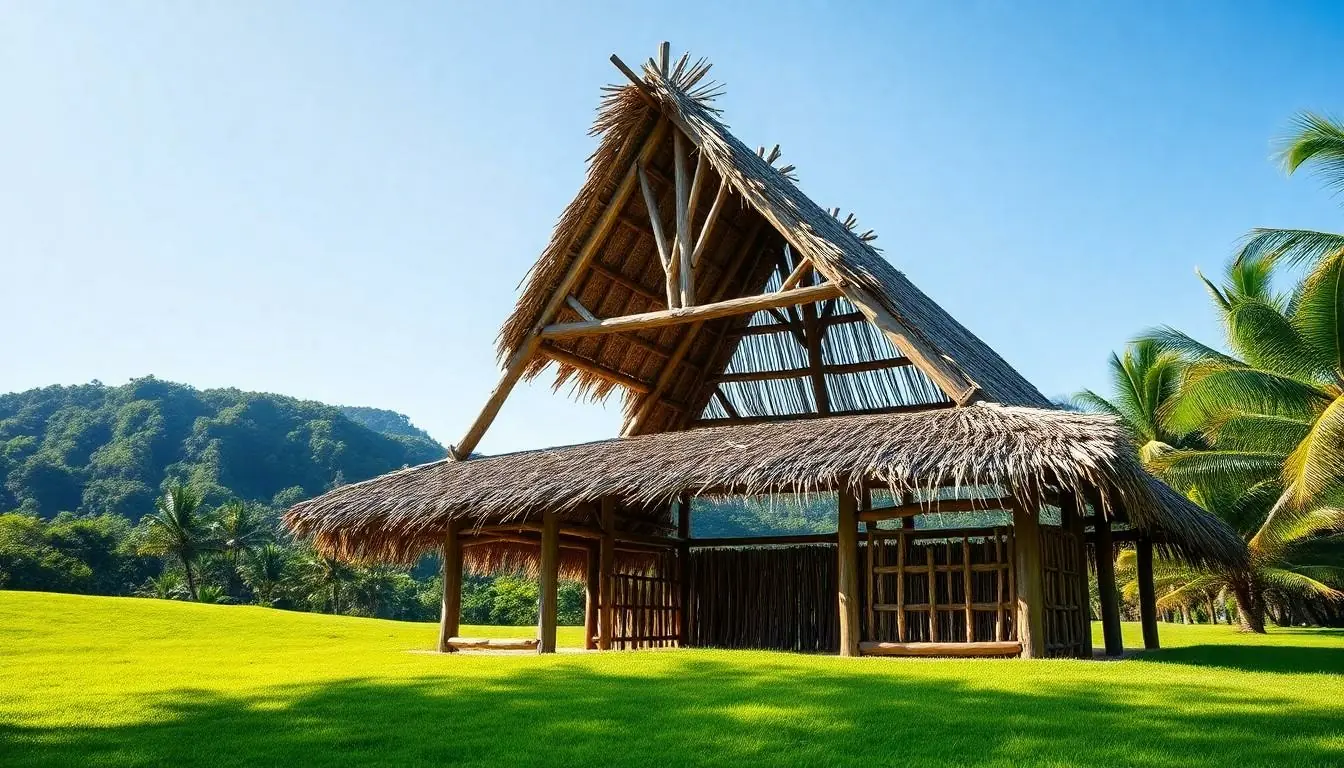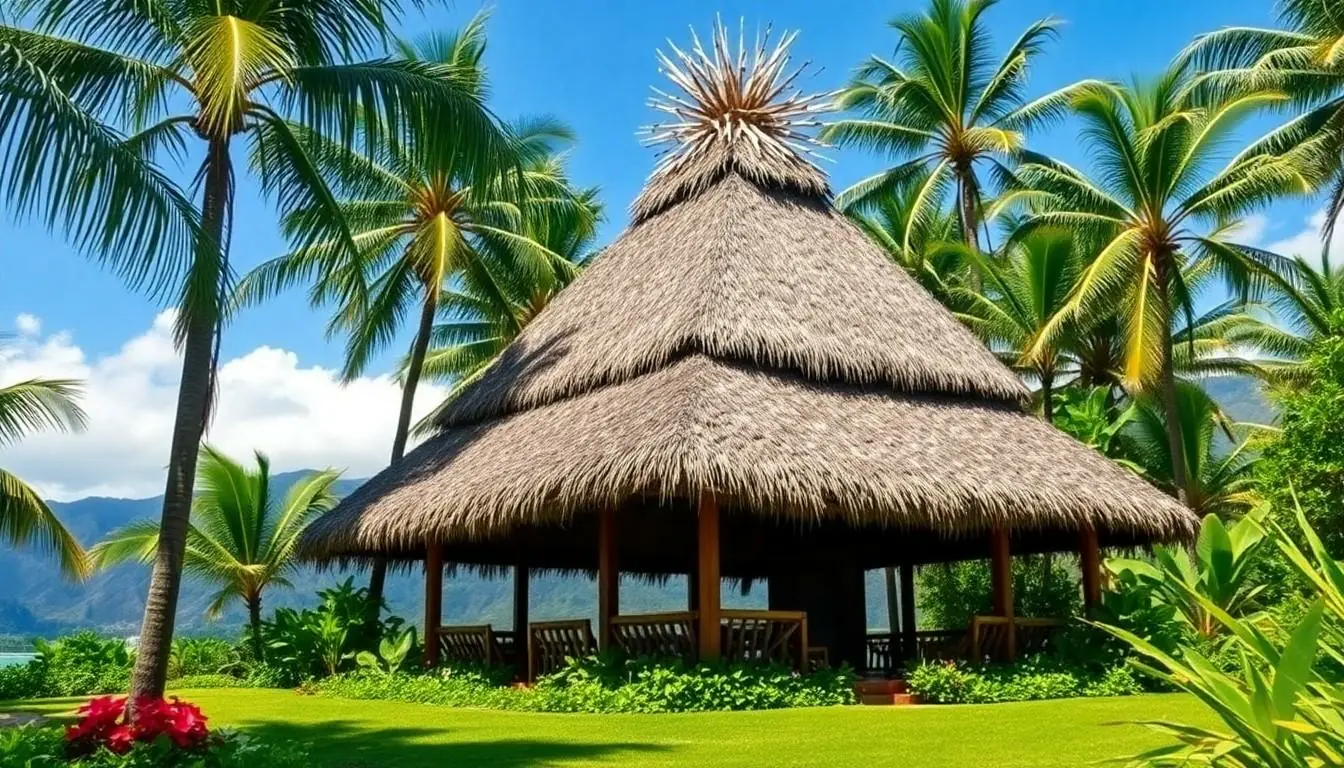Hawaiian architecture isn’t just about building structures; it’s a celebration of culture, history, and the Aloha spirit. From the iconic thatched roofs of traditional hale to the modern designs that blend seamlessly with nature, this architectural style tells a story as rich as the islands themselves. Imagine lounging in a space that feels like a warm hug from the sun while being surrounded by breathtaking landscapes.
But it’s not all sunshine and rainbows—Hawaiian architecture faces challenges too. Climate change and tourism pressures threaten to alter its unique charm. Understanding these architectural wonders can inspire appreciation and preservation efforts. So grab your virtual surfboard and ride the wave into the captivating world of Hawaiian architecture, where every structure has a tale to tell and a lesson to share.
Table of Contents
ToggleOverview Of Hawaiian Architecture
Hawaiian architecture reflects a rich cultural tapestry rooted in the islands’ history and traditions. This architecture displays a blend of indigenous practices and modern influences, resulting in structures that resonate with the landscape. Traditional forms, such as the hale, feature thatched roofs and open spaces, serving both functional and spiritual purposes.
Modern Hawaiian architecture incorporates sustainable design elements, emphasizing harmony with the environment. Natural materials, including wood and stone, create a sense of connection to the land. Innovations in roofing and ventilation enhance energy efficiency, crucial in the tropical climate.
Notably, the use of large windows and open floor plans promotes airflow and views of the stunning surroundings. The aesthetic often draws inspiration from local flora and fauna, integrating indoor and outdoor spaces. Contemporary architects prioritize cultural narratives, ensuring new designs honor traditions while meeting current needs.
Climate change poses challenges for Hawaiian architecture. Rising sea levels and increased storm intensity impact coastal structures. Architects seek resilient designs that withstand these pressures. Balancing preservation and innovation remains essential in maintaining the islands’ unique architectural heritage.
The appreciation of Hawaiian architecture extends beyond aesthetics. Each structure tells a story linked to the community and its values. Encouraging engagement with these buildings fosters a deeper understanding of Hawaiian culture and history. Through thoughtful design and preservation efforts, the legacy of Hawaiian architecture continues to inspire future generations.
Historical Context

Hawaiian architecture reflects a rich historical tapestry shaped by cultural influences and significant events. Traditional structures reveal the depth of Polynesian heritage while modern designs illustrate adaptation to contemporary needs.
Influence Of Polynesian Culture
Polynesian settlers brought distinctive architectural styles to Hawaii between 300 and 800 AD. They constructed the hale, a simple structure made primarily from native materials like wood and thatch. These buildings served essential purposes such as living quarters, meeting places, and spaces for cultural ceremonies. The connection to nature remains evident in these designs, showcasing a harmonious relationship with the environment. Cultural traditions and the Aloha spirit influenced functionality and aesthetics, resulting in open layouts and communal spaces.
European Colonization Impact
European contact starting in the late 18th century marked a turning point for Hawaiian architecture. Missionaries introduced Western building techniques and materials, leading to the construction of more permanent structures. They built churches and schools, significantly altering the architectural landscape. Colonial influences merged with existing styles, producing unique creations that reflect both heritage and adaptation. The introduction of new materials like brick and glass transformed the traditional aesthetic while prompting a reevaluation of local practices.
Key Characteristics Of Hawaiian Architecture
Hawaiian architecture features distinctive elements that convey the islands’ cultural identity. Significant characteristics include the use of natural materials and integration with the landscape.
Use Of Natural Materials
Natural materials form the foundation of traditional Hawaiian architecture. Builders often utilized wood, thatch, and stone sourced locally. These materials not only enhance aesthetic appeal but also offer strength and durability. Thatch roofs, made from palm or sugarcane, provide effective insulation against tropical elements. Stone walls resist extreme weather while blending seamlessly into the surroundings. Modern architects continue this tradition by incorporating sustainably sourced resources, such as bamboo and native hardwoods. A commitment to eco-friendly practices emphasizes the importance of respecting the islands’ ecology.
Integration With The Landscape
Architectural designs in Hawaii harmoniously connect structures with their natural environments. Site selection prioritizes scenic views and natural features, allowing buildings to complement their surroundings. Large windows capture breathtaking vistas and facilitate natural ventilation. Outdoor spaces seamlessly interact with indoor areas, blurring the lines between nature and habitation. Sloped roofs mimic the peaks of nearby mountains while shading living areas from intense sun. This thoughtful integration fosters a sense of place and underscores the relationship between inhabitants and the land.
Notable Examples Of Hawaiian Architecture
Hawaiian architecture showcases a remarkable blend of traditional and modern influences that reflect the island’s cultural richness.
Traditional Hawaiian Structures
Traditional Hawaiian structures represent a deep connection to the land and cultural identity. The hale serves as a key example, functioning as a dwelling and community space. Constructed with locally sourced materials like wood and thatch, these structures adapt to the tropical climate. Their open designs promote airflow, enhancing comfort in warm weather. Additionally, the pu’u honua, or place of refuge, exemplifies spiritual significance and safety, offering a sacred space within the community. Each traditional structure embodies practices passed down through generations, illustrating the importance of sustainability and harmony with nature.
Modern Hawaiian Architectural Designs
Modern Hawaiian designs prioritize eco-friendliness and cultural narratives while embracing contemporary aesthetics. Architects incorporate energy-efficient features, such as large windows and open floor plans, to enhance natural light and airflow. These modern buildings often utilize locally sourced materials, creating a seamless connection to the environment. Spaces frequently blend indoor and outdoor areas, allowing inhabitants to enjoy Hawaii’s stunning landscapes. Additionally, contemporary designs frequently draw inspiration from traditional elements, ensuring that the essence of Hawaiian culture remains present. Through thoughtful architecture, modern designs continue to celebrate and preserve the unique spirit of the islands.
Preservation And Conservation Efforts
Preservation and conservation efforts play a crucial role in maintaining Hawaiian architecture’s integrity and cultural significance. These initiatives aim to protect the unique aesthetic and historical narratives embedded within structures.
Importance Of Cultural Heritage
Cultural heritage offers a sense of identity and belonging. Recognizing the significance of traditional architecture, communities can foster pride and encourage the transmission of knowledge across generations. Structure preservation enables the continuation of local customs and practices, deepening connections to the land and history. Engagement with these heritage sites creates opportunities for education and revitalization, enhancing community resilience. Many organizations actively promote public awareness regarding the importance of preserving both traditional and modern architectural forms. These efforts not only safeguard physical structures but also nurture the cultural narratives they embody.
Challenges In Preservation
Preservation efforts face several notable challenges. Climate change poses a significant threat, with rising sea levels and extreme weather events jeopardizing coastal sites. Limited funding and resources often hinder restoration projects, preventing timely interventions. Additionally, urban development pressures contribute to the loss of traditional spaces, creating conflicts between modern growth and heritage conservation. Local communities may have differing priorities that complicate preservation efforts. Collaboration between government entities, local organizations, and the public proves essential in overcoming these obstacles. By addressing these challenges, stakeholders strengthen their commitment to maintaining Hawaii’s architectural legacy for future generations.
Hawaiian architecture stands as a testament to the islands’ rich cultural heritage and deep connection to nature. Its evolution reflects the adaptability and resilience of its people while honoring the past. By blending traditional elements with modern practices, architects continue to tell the stories of the land and its inhabitants.
The ongoing challenges of climate change and urban development highlight the need for preservation efforts. Communities must unite to protect and celebrate this architectural legacy, ensuring that future generations can appreciate the beauty and significance of these structures. Embracing both history and innovation, Hawaiian architecture remains a vibrant expression of identity and spirit.



